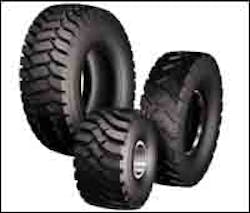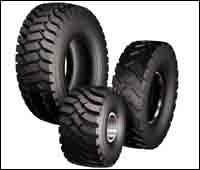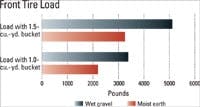Are You Managing Lower Tire Costs?
By now you know that tires are your second largest expense, behind fuel. By now you know that controlling tire cost is a critical component of remaining profitable. By now you know the fundamentals of controlling tire cost. What you may not know is how to manage your tires most effectively.
One of the best tools for tire management is the tracking software available from tire manufacturers. While the software is available to end-users, most fleet managers work with their tire dealer who enters the data, generates reports, and uses the program's other features to maximize the value for the customer.
With more than 60 reports available from these programs, it's important to work with your vendor to determine which reports best match your goals and concerns. Rocky Williams at Parkhouse Tire in Fontana, Calif., gave some examples of reports available from Bridgestone's TreadStat software. "You may want an asset report, giving the results of the latest inspection or survey by equipment or asset. You can also check tires and service by vehicle. The results are similar to the asset report, but include projections of remaining tire life. Service managers find value in quick reports that indicate approximate remaining tire life by color coding each wheel position of each piece of equipment."
Tim Good, manager of global customer accounts for off-the-road (OTR) tires at Goodyear, said the three reports he thinks have the most value for customers are the scrap-tire-removal report, the cost per hour for tires, and the comparison of actual and projected cost per hour.
These reports shed light on the value of specific tires. They also identify problems by wheel position with individual pieces of equipment. And by studying the scrap-removal report, a fleet manager can determine what types of failures are occurring and at what point they're occurring in a tire's life.
"Most people don't have the staff to do tire tracking in-house," said Homer Bonheimer, a sales representative with Miller Brothers Tire in Cayce, N.C. "If you have someone like us providing the service for free, why would you do it yourself?"
Most dealers provide the service for free to enhance the value their customers receive from them. It also helps keep the customers loyal to that dealer. While dealers don't typically set conditions for providing this service, things can get complicated if the dealer doing the tracking is not the customer's exclusive supplier. With exclusivity, the tire dealer is assured of complete, accurate data, since it is the dealer in the field servicing the equipment.
End-users can purchase tire-management software and keep their program in house. TreadStat is $999 for the first license, $499 for the second, and $249 for the third and subsequent licenses granted to the same business. Goodyear's EMTrack III is $1,299 per copy.
Williams said Parkhouse Tire uses Bridgestone's TreadStat software to administer a management program for Vulcan Materials. "We track every tire—new or used, retreads, any brand—throughout its life cycle at 16 or 18 Vulcan locations," said Williams. "The information goes to both Vulcan and Bridgestone." The program works best, Williams said, when the customer designates one person to work with Parkhouse.
Jim Bailey, product manager in Vulcan's corporate procurement group in Birmingham, Ala., said the company's relationship with Parkhouse exemplifies how such a program should work. "Whenever a tire is changed," said Bailey, "it's that person's responsibility to give us hour meter readings, tire ID, the compound, the original thirty seconds of tread depth, the cost, date, and all the other information we need.
"We have 22 service providers for our 315 locations across the country," said Bailey. "We establish our expectations, and we communicate those expectations to the providers."
Bailey said that while the expectations are very specific, they cover five general topics: communications, product support, parts support, claims resolution, and training.
"We do the purchase agreements with the tire manufacturers, so we need a strong national relationship with them. We also need a dealer network that's locally focused. We don't dictate to our sites who they'll do business with. It's important that those site managers have an active role in selecting their service provider. The managers are the ones who will be working with that provider on a day-to-day basis."
Mike Monnot says H.B. Zachry also manages tires for its nationwide fleet from a central office in San Antonio. They monitor about 1,900 off-highway tires. (They don't track any on-highway tires.) To facilitate tracking, Zachry brands their tires.
The appeal of the program, said Monnot, is cost control. "If you can't measure it, you can't control it." He estimates the firm saves $50,000 per year in clerical and administrative costs by using software. "Tire costs are harder to compute," he said, "although we know there are savings on every tire."
Bonheimer pointed out the two ways he feels tire-management software contributes most to savings. First, he said, the program will help select the right tire. "And not just Bridgestone," he said. "Any brand." Then it will select between bias ply and radial. Then it selects a tread type. The program also projects hours of service life remaining for a tire, which helps with budgeting and the scheduling of downtime.
With tire dealers so willing and able to manage tires, what tasks remain for the customer? Pat Sweetman, maintenance shop manager for Concrete Materials in Sioux Falls, S.D., says his personnel are the eyes and ears for his Goodyear dealer. "Our people check tire pressure (on more than 100 on-road ready mix and dump trucks) at the beginning and end of each shift as part of an inspection. They report any problems to the dealer." That dealer is on site several times each week to do more thorough inspections and enter data into the tracking software.
Some end-users buy the software even if their dealers are actively involved in the management program and are also using the software. Having the software enables those end-users to generate reports and perform other management tasks when they want.
For Trumbull, having the software hasn't been as big a help as they had hoped, said Bob Decker, corporate equipment manager. "We've tried programs from several vendors, and none has integrated with our office-management software the way we had hoped." Trumbull uses Profitool, and is working with Profitool to develop tracking software. Trumbull had tried to get the right fit from tire manufacturers' software for three years before asking Profitool to develop a program. "It's frustrating," said Decker, "but we'll be using this system for a long time, so we know we can't be in a hurry."
In the meantime, Trumbull is tracking the data that they'll input to the software. Whenever a tire is repaired or replaced, a Trumbull employee records the date, unit number, hour meter, tire size, tire make, tread depth, tire position on the machine or truck, the person or company doing the repairs, and the serial numbers of the tires coming off and going on. There's a check box for the type of problem, such as "flat," "blown" and "pieces missing" and room for a few notes. The form is sent to the shop. After Decker reviews the form, it is put in the file for that particular machine. "Until we find the right software program to fit our needs, this paper system is working for us," said Decker.
Tires have become sophisticated products. If your program for managing them isn't equally sophisticated, it's time to upgrade.


